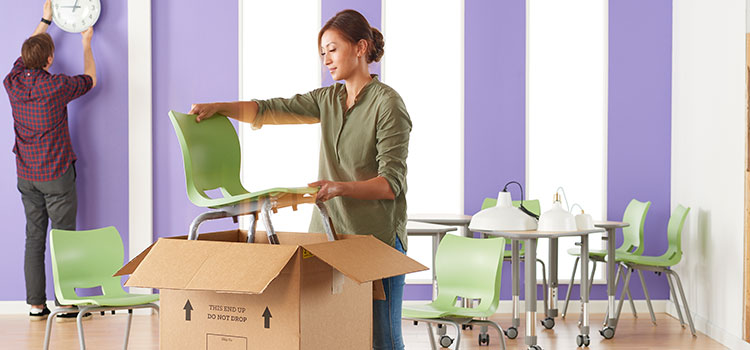How to Buy Furniture for a New School
Congratulations… If your school just received funding to build a new school or purchase new furnishings, it’s an exciting time! But getting from the green light to a grand unveil will involve a heap of decisions, including how to buy new school furniture. Fear not; we can help! Frost-Barber is here to help simplify the furniture-buying process along with our partners at Smith System, a leading pre-K-12 school furniture manufacturer. We want to lessen the learning curve for schools facing the budgetary responsibility of furnishing the spectrum of one or two classrooms, to entire new school buildings with makerspaces, media centers, commons and more.
Bill Stoyke, an experienced regional sales manager with Smith System, shared his best practices with us, including his most helpful gems on decision-making, budgeting, process, timelines, tips and pitfalls. Foremost, he stresses to never underestimate the role of classroom design and furniture in learning. “Smith System® wants to help schools understand how improved classroom design can positively impact student outcomes. Schools are the education experts. We are the furniture experts. Together, we can develop highly functional, future-proof spaces that will outlast any one administrator, teacher or student.”
Here’s a condensed 10-step guide to place a school furniture purchase order (P.O.).
STEP ONE: Establish project teams and assign roles
This will vary by district size, but a typical team often includes:
• Superintendent – establishes team, project vision and consistency with district goals, and timeline; this person is the ultimate decision-maker
• District Business Manager – budget and procurement
• District Facilities Manager – quality assessment
• Principal – articulates school’s goals, manages teacher representative group activities
PITFALL: Roles aren’t clearly defined or communicated.

STEP TWO: Team Visioning
1. The team creates a vision for key areas of the new school with staff from each area. (You’ll want to share this with your eventual furniture partner at the outset of the project.)
Answer essential questions:
- Group sizes and teaching strategies used?
- How do teachers want to re-imagine their classrooms?
- The role of technology?
- Storage needed?
- Budget?
2. The team creates a list of current furniture challenges and needs/wants by area:
- Classrooms
- Library/media center
- STEM/makerspace
- Commons
- Specialized areas (intervention, special education, etc.)
TIP: Put furniture needs into four categories to keep it simple: student seating, student desks/tables, teacher items (desk or landing areas, storage), and overall storage.
PITFALL: Leadership makes assumptions without engaging staff, which can lead to going down the wrong path. The result is wasted time or, worse, purchasing furniture that doesn’t achieve your goals.
STEP THREE: Vendor Selection
The superintendent drives this process. It’s influenced by whether you’re already working with a specific manufacturer, a local furniture dealer, and/or your architectural firm’s interior designer. Keep the evaluation period short (30 days start/finish), so that you can use your chosen vendor to guide you the rest of the way.
Consider:
- What qualities are you looking for in a vendor partner? For example, the ability to meet summer delivery and installation timelines, types of services offered, services provided (free vs. paid), specific vendor reps involved?
- What projects have they successfully completed that are similar in scope to yours?
- How will you find and invite vendors to participate?
- What contract vehicles are available through each vendor vs. bidding out the furniture purchase?
PITFALL: Letting price alone drive all decisions, rather than a blended mix of important criteria including price, functionality, durability, ergonomics and aesthetics. An established vendor who specializes in K-12 furniture can help you accomplish your goals – and spare you massive time and energy drain.
STEP FOUR: Begin implementation
Once you’ve chosen a vendor, let your vendor representative conduct a few initial meetings (one with leadership only; separate meetings to interview staff) to understand your needs in greater detail.
Give the vendor your:
- Vision
- Budget
- Spaces to be furnished – prioritized in case of budget changes
- Building layout with dimensions
- Specific furniture items to be evaluated, based on your needs
COST NOTE: Some furniture dealers may charge for layout and design services, while others may not. It often depends on whether the school commits to buying its furniture through a dealer as its chosen vendor partner. (Smith System provides free visioning, needs assessment, concepts, budgeting and in-service furniture education for administrators and teachers.)
STEP FIVE: School Tours
Based on your goals, along with some initial education about furniture, your vendor can help arrange tours of a few schools, depending on geography and staff availability. These field trips (yup, adults get them, too) will show real-world use of furniture that may align with your vision and goals.
STEP SIX: Sit, Touch & Try, Furniture Visit
Everyone on the project team should attend this to hear the same message at the same time.
Based on your stated needs, your vendor will:
- Show furniture samples – brought to your school or you’ll go to the vendor’s showroom
- Conduct a large group presentation on features and benefits of different styles
- Allow your team to get hands-on with the product – sit, touch, try
- Conduct one-on-one or small group Q&A to address specific needs
TIP: Do this as a team. It’s valuable to hear one another’s questions and comments in real time.

STEP SEVEN: Plan and prepare for a trial classroom
Based on outcomes from Step Six – “Sit, Touch, Try”, the team should narrow down a list of furniture items to test in a trial classroom or two. Try several shapes, seating styles and heights (grade dependent). Be sure to allow for manufacturing lead time, delivery and installation.
TIP: The principal should select a pilot classroom with an energetic teacher interested in the exciting changes ahead. Consider rotating furniture to other classrooms, too. This gives your trial classroom the best chance for success (translation: great feedback for the vendor).
PITFALL: Selecting only one style of desk or student seating. Try a few styles and sizes. They might surprise you with their versatility or functionality.
STEP EIGHT: The trial classroom experience
After the test furniture arrives, have your vendor conduct a quick refresher with the teacher(s) to review how each piece functions. Allow teachers (and students) about a month to experience the furniture, then have the vendor return to answer questions. This is a great time to fine-tune selections, like shapes, sizes, accessories and options.
TIP: It’s unlikely that dealers and manufacturers will provide a full classroom of furniture for free. But they may give you a one-time low price to try the furniture, for which you’ll get to choose all the finishes and own. In this case, it’s not incremental to your existing furniture budget, but rather helps your existing budget go further.
PITFALL: Piloting furniture that is out of budget, thereby setting false expectations with staff and wasting valuable time.
STEP NINE: Design, budgeting, and lead time planning
Narrow your team to the superintendent, business manager and principal. You’re now ready to compile furniture specifications, quantities and a line item budget for each room. Lay out each room (or a representative room if all classrooms are the same size and you have a common furniture “kit of parts”) to ensure the furniture will fit and function right.
Allow enough time to make revisions (construction costs may have dented your original budget.) Your dealers and manufacturers will coordinate lead times and advise your choices, based on your deadline. Most manufacturers require a P.O. by a certain date to allocate inventory and commit to a delivery date.
TIP: It’s important to have a cohesive plan for furniture colors and finishes. Factor in school-spirit colors and the need to differentiate spaces, but also consider coordinating color by grade levels where you have common furniture sizes so that furniture can be moved from room-to-room if/when classroom populations change over time.
PITFALL: Letting each teacher choose different furniture pieces and colors. That may make current teachers happy, but it does not future-proof the furniture, should those teacher(s) leave the school. This is where leadership should consider staff input, but ultimately make decisions based on the best long-term interests of the district.

STEP TEN: Finalize P.O. Homestretch!
The final step is to finalize and receive board approval (if required) on your furniture list, finishes and cost. Then place your P.O., and congratulate your team on a furniture-buying mission accomplished.
Frost-Barber has over 50 years of experience designing, specifying and furnishing classrooms, schools and universities across the entire state of Louisiana. We have a specialized sales team for Education Facilities and can help make your next furniture-buying experience easy and stress-free. Reach out today for more information on how Frost-Barber can move your project forward! Email Elizabeth Carter-Thibodeaux to get connected.

